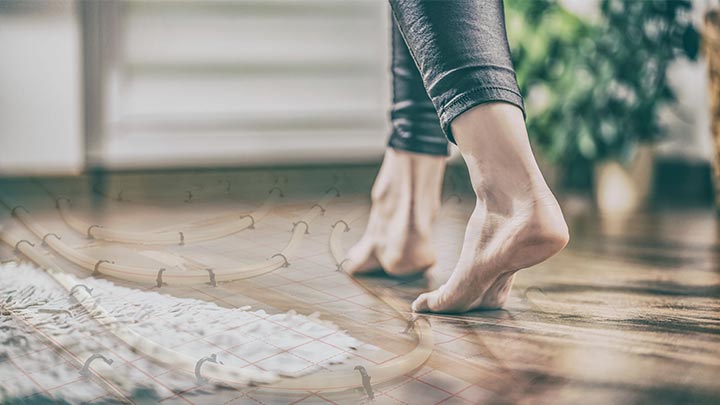In recent years, underfloor heating can be found in an increasing number of homes in Poland. Investors appreciate this type of solution because it allows to effectively reduce the heating costs of single-family and multi-family buildings.
 Gone are the days when underfloor heating was an exclusive heating installation, installed only in the most luxurious homes. Today, many investors choose this solution, appreciating the energy efficiency and thermal comfort of underfloor heating. The very fact that in this case the floor is not cold and it is a pleasure to walk on it even barefoot, significantly increases thermal comfort. But is it really worth installing underfloor heating? Before we check it, it is worth explaining what elements such an installation consists of.
Gone are the days when underfloor heating was an exclusive heating installation, installed only in the most luxurious homes. Today, many investors choose this solution, appreciating the energy efficiency and thermal comfort of underfloor heating. The very fact that in this case the floor is not cold and it is a pleasure to walk on it even barefoot, significantly increases thermal comfort. But is it really worth installing underfloor heating? Before we check it, it is worth explaining what elements such an installation consists of.
Elements of underfloor heating
Underfloor heating is nothing more than pipes connected to a heat source and placed in the floor screed (screed layer). In this way, the floor surface becomes one large radiator. Pipes are one of the basic elements of this heating system. They can be arranged in various ways, e.g. in a loop (uniform temperature distribution on the floor), in a loop with an edge zone, in a meander (in the case of a wooden floor structure, in rooms with partitions, etc.) and in a meander with an edge zone. There are various types of pipes on the market, e.g. homogeneous pipes with an anti-diffusion barrier (PEX, PE-RT) or multilayer pipes with an aluminum insert available in coils from 100 to 600 m, which makes laying them much easier).
Check out underfloor heating at the Onninen wholesaler
The next elements are moisture insulation (e.g. Onnline foil 1.05x50m), edge insulation in the form of a tape (e.g. edge tape with glue 8x150mm ONNLINE), which acts as an expansion joint from external walls, and thermal insulation (e.g. polystyrene boards of various thicknesses). . Underfloor heating also requires the use of a distributor, whose task is to help distribute water evenly in the coils, as well as control automation.
Advantages of underfloor heating
It is not by accident that more and more investors decide to install underfloor heating. Such an installation has many advantages, including:
- high thermal comfort - you can lower the heating by even 1-2°C, which allows you to reduce heating costs by about 12% during the year;
- the air is not as dry as when using traditional radiators (higher humidity), which helps reduce the multiplication of mites;
- optimal temperature distribution for the human body (lower above the torso, higher near the feet);
- great interior aesthetics and greater arrangement possibilities - the installation is invisible, you can use the space effectively;
- an ideal solution for people suffering from allergies and asthma - no radiators that collect dust, and no air convection from the radiators and no dust rising;
- lower heating factor consumption than with radiators, which often require a supply temperature above 60°C, while with underfloor heating 45°C is sufficient;
Disadvantages of underfloor heating
Of course, there are some disadvantages to underfloor heating. The most frequently mentioned include:
- investment cost approximately 30% higher than in the version with radiators ;
- the need to perform installation before laying the floor;
- in the event of a breakdown, part of the floor must be chipped away;
- restrictions regarding the floor - stone and ceramics work best, but you have to give up fluffy carpets;
- the route of pipes must be taken into account when arranging furniture and toilets - it is better not to place heavy furniture or toilet bowls on them;
- high thermal inertia - the floor heats up slowly and cools down slowly.
The most popular brands of underfloor heating products in Onninen:
How much does a floor tile cost?
Finally, it is worth saying a few words about the costs of underfloor heating. We have already mentioned that the cost of such an installation is higher than using traditional wall radiators. However, it is worth remembering that underfloor heating allows you to reduce your bills during operation. In the case of wall radiators, you can expect to spend up to PLN 4,300 a year, while with underfloor heating you can reduce it by as much as PLN 600-700 a year. The cost of installing underfloor heating may vary, but most often ranges from PLN 80 to PLN 140 per 1 sq m, which includes both a set of materials and labor. Of course, these costs can also be optimized by using an attractive offer of underfloor heating elements, for example in our wholesale store.

